247 MILLION YEARS AGO
Following the horrendously massive extinction at the end of the Permian period, methane levels in the atmosphere fluctuated widely from the expected normal levels of around 2,200 parts per million. The fluctuations occurred between 278 million and 250 million years ago of roughly 5 major peaks with the first one being the biggest reaching around 4,400 parts per million.
During these exceptionally high methane peaks and subsequent global warming conditions, the interior of the great supercontinent appeared more desert-like because conditions on land were hot and dry. Only the coastal regions remained sufficiently humid to support ground-covering ferns, tall tree-like ferns such as Dicroidium, conifers and cycads, and an increasingly more diversified and flourishing insect population.
Then the methane peaks eventually became troughs as the conditions began to cool down a little and rainfall increased. Soon the plants edged their way once again towards the interior of the supercontinent until much of the land became a huge tropical forest, thereby stabilising the fluctuations in climate from the methane.
245 MILLION YEARS AGO
In the same way the plants expanded across the continents, there was a similar expansion in animal numbers over the next few million years. Nothing unusual here, except what differed in this sudden burst (in geological terms) in life compared to the Cambrian period was the greater numbers of animals of a particular theme rather than an all out innovative stage of evolution.
As Roger Lewin, author of Complexity: Life at the Edge of Chaos, wrote:
"...there have been tremendous bursts of innovation...in the history of life, mostly in the wake of mass extinctions. For instance, following the Permian extinction some 250 million years ago, in which an estimated 96 percent of existing species perished, the rate of innovation almost matched that of the Cambrian. But the innovation was principally variations upon existing themes; no major new themes were added. In the Cambrian, by contrast, innovation was largely at the level of producing new themes, with variations upon them being relatively minor." (1)
235 MILLION YEARS AGO
With many new predators competing for the abundant supply of food on land, a number of reptiles and a few mammal-like animals decided to return to the sea. Those other animals brave enough to stay put evolved to have features designed to increase their survival rate. (2)
Among the land-based creatures that successfully evolved at this time included the first true hairy-like mammals and the first dinosaurs (the name comes from the two Greek words deinos, "terrible", and saurous, "lizard"). However, it would be the dinosaurs who would dominate life on the great supercontinent (known as Pangaea) for the next 170 million years.
Evidence to support the existence of this great supercontinent can be seen from the fossil evidence. The fossils show animals of the Triassic Period were widespread and remarkably alike throughout all the continents of the world. But later, after the supercontinent broke up during the Jurassic Period at around 210 million years ago (and with further isolation of animal communities as the seas rose in the early Creataceous period), the animals diversified into more unique forms based on locality.

230 to 180 MILLION YEARS AGO
The Sun is known to take approximately 225 million years to travel one revolution around the Milky Way. Thus nearly one revolution around the galaxy ago, the Earth was just starting to be dominated by the dinosaurs.
The early dinosaurs were small creatures by our standards, but they later evolved into some of the largest land animals that ever lived. Part of the reason for these changes included a new hip structure in the predators allowing these animals to bring their legs closer together and lift the entire body with greater ease compared to those older animals whose legs came out the side and scuttled around. As a result, these predators could move more quickly. Indeed, some predators became so confident in their new hip structure that a few evolved the ability to run almost entirely on two legs with the remaining limbs becoming nothing more than mere stumps. For the plant-eating animals, they had no choice but to evolve to better survive the onslaught from these predators. This included the development of tough armour plating along the spine, neck and head region, turning large tails into lethal weapons, and simply to gain greater size to overwhelm the predators. Other plant-eaters may choose to stay small and agile and would use the vegetation to hide or camouflage itself as the best form of defence. During these evolutionary changes over the next 50 million years, huge plant-eating dinosaurs like the Apatosaurus (formerly called Brontosaurus), Briachiosaurus and Sauropods, and large terrifying meat-eaters such as the Tyrannosaurus Rex roamed the Earth.
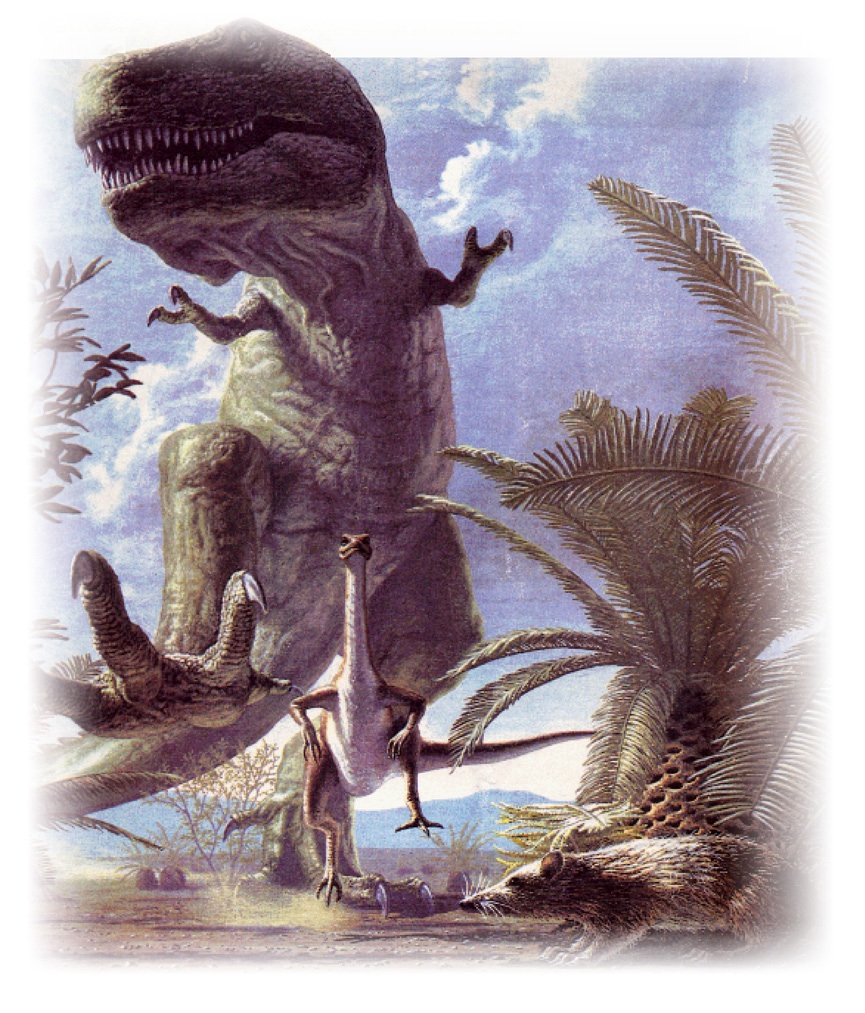
This was a time when size did matter. Not only was there a plentiful supply of food on the great supercontinent to support very large dinosaurs on land — a kind of giant "smosgasbord" of fresh meat and vegetation just sitting out there ready for the taking — but also there was a survival bonus: the larger the animal can become, the more easier it is for the animal to survive the attack of most predators. Brings back memories of the reason why single-cells came together in the first place to survive an attack from predators: lose a few cells from a bite won't matter too much. And so it is the case for some plant-eating dinosaurs of this period.
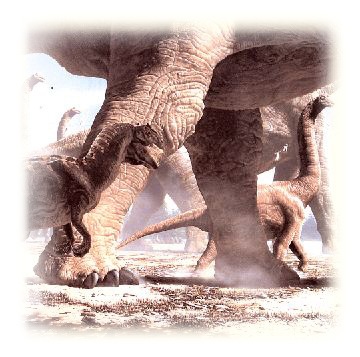
Despite size being an important factor in the survival of many dinosaurs, they had one major weakness: the reptiles did not develop a quick and effective internal body temperature-regulator. Not a major issue for the dinosaurs as there would be an extremely persistent period of very warm, moist tropical-like climate existent throughout much of the world for at least the next 50 million years.
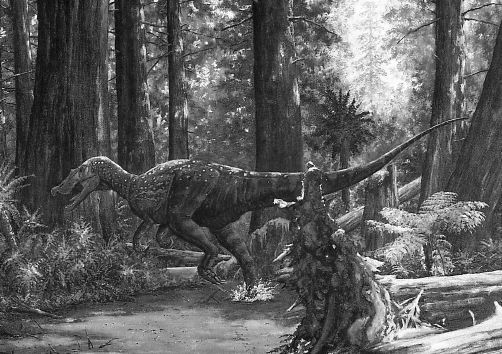
Mammals, on the other hand, did develop a primitive internal body temperature-regulator suggesting that they were adapting to the lower temperatures existent at the extreme northern and southern latitudes on Earth, on mountain-tops, deep inside certain caves, or during the night where the great dinosaurs were probably more sluggish or kept themselves around lakes and shallow inland seas (which would have absorbed a lot of heat during the day), thereby allowing the mammals to remain hidden from view. Those mammals that did become nocturnal, remained small but their eyes and ears became more enlarged and sensitive to the darker environment.
Land-based mammals of this era were almost certainly small creatures living secretly and did not evolve into larger more complex creatures until the great dinosaurs disappeared.
NOTE 1: A large mammal would be too much of a target for the highly developed and powerful muscle structure of the two-legged carnivorous dinosaurs which gave these terrible lizards excellent speed (in a roughly straight line for the larger predators) to capture practically all large, cumbersome prey. Mammals of this era had to remain small and agile. (3)
NOTE 2: Mammals are not the only creatures to develop fur on their skins. Some smaller dinosaurs living in the temperate and polar regions also developed filaments of hair. These filaments became more abundant and colourful as a means of attracting a female partner. Eventually a point came when enough of these filaments allowed some lightweight dinosaurs to glide through the air, and later to use the heavily feathered front limbs to create enough force to push the animals through the air and achieve lift. We call these animals birds. Apart from the crocodiles and some other small reptiles, birds are the only dinosaur species to survive to this day.
210 MILLION YEARS AGO
The great supercontinent began to split apart.
Huge prehistoric forests comprising of cycads and conifers together with a thick undergrowth of ferns covering the ground were on the increase and dominated much of the great supercontinent. The evidence to support the size and abundance of these forests can be seen today from the presence of great coalfields in Europe, Australia and other parts of the world. (4)
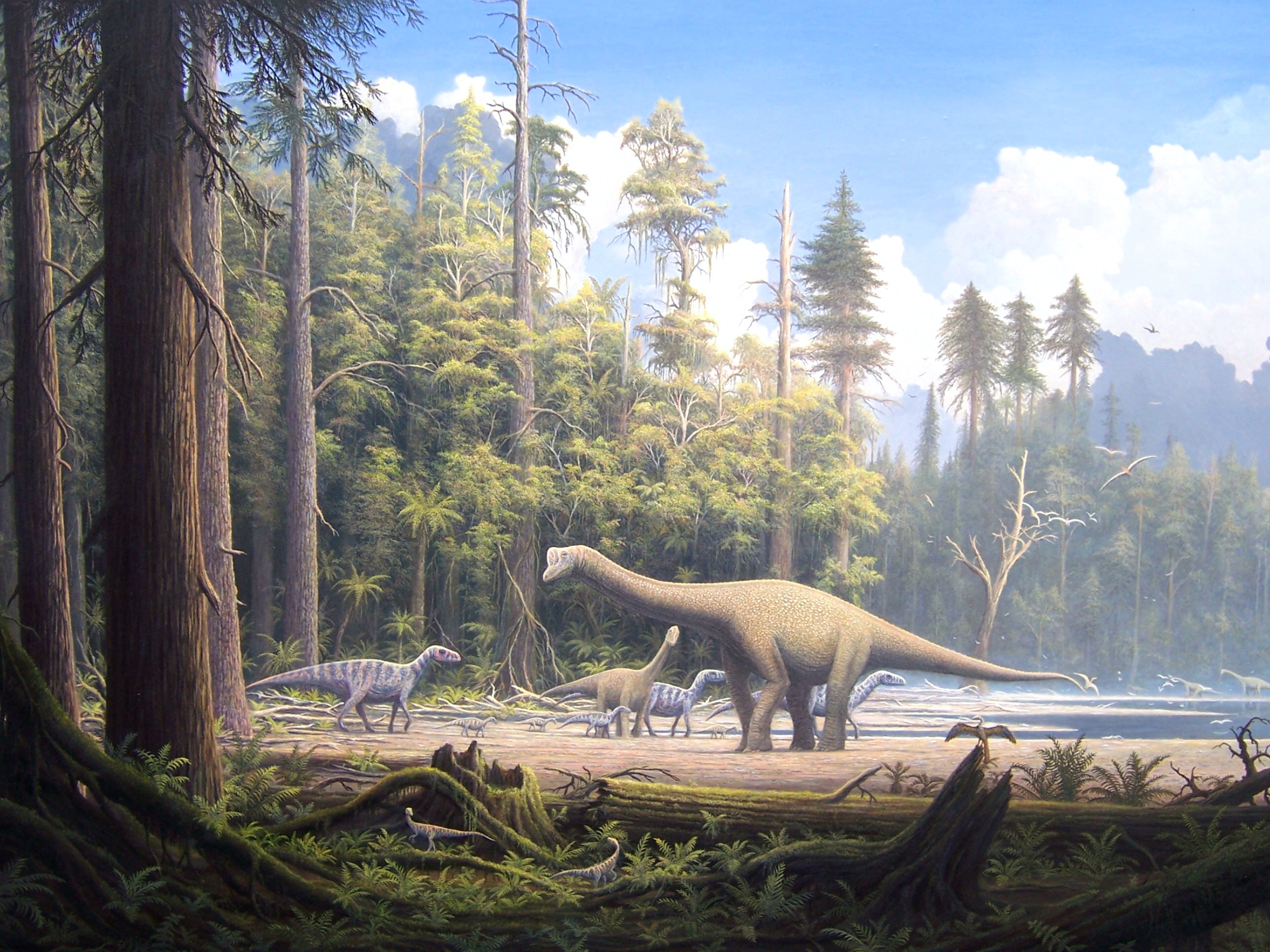
190 to 195 MILLION YEARS AGO
A seaway separated the northern continent (North America, Europe and Asia) known as Laurasia, with the southern continent (South America, Africa, Australia, Antarctica, and India) known as Gondwana land. (5)
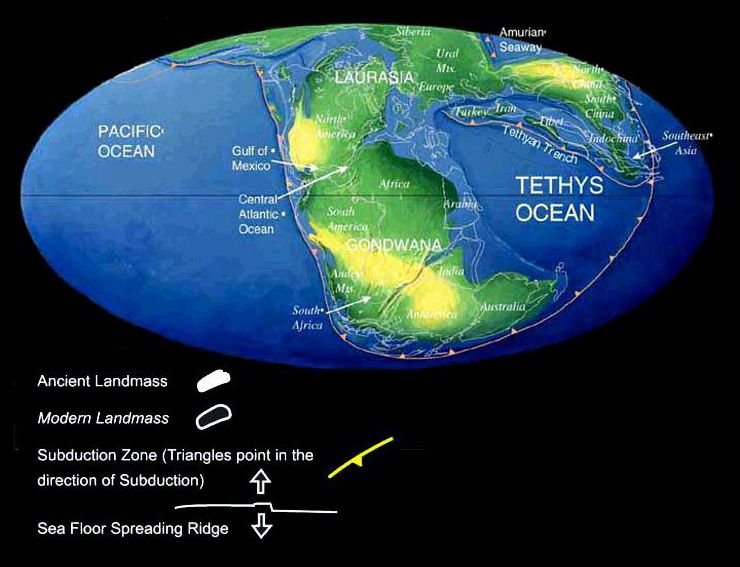
Also worth mentioning at this time is the work of a team of Chinese and American scientists who have discovered in the rich fossil beds of Yunnan province in China a 12mm long 195 million-year-old skull from a tiny animal no larger than a paper clip. What makes this prehistoric skull so remarkable is its bone structure. According to the scientists, this is the oldest known creature having the distinctive and crucial mammalian feature of having a one-boned jaw for better control of chewing and three middle-ear bones for improved hearing. Furthermore, the name given to this creature — Hadrocodium wui — means "full head" because of the skull's relatively large brain-holding capacity. Scientists believe a large brain did develop inside this skull because the animal utilised these distinctive anatomical features for its survival.
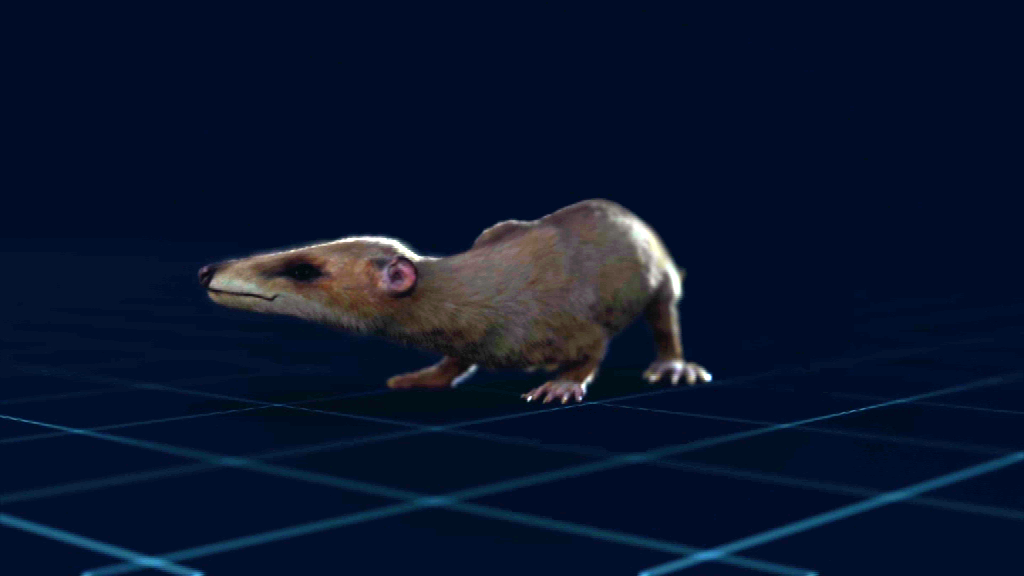
Zhe-Xi Luo, a member of the American team from the Carnegie Museum of Natural History in Pittsburgh, Pennsylvannia, said:
"Hadrocodium could be our distant cousin, an early mammal that existed alongside the ancestor of living mammals." (6)
NOTE: Mammals with a womb to carry its offspring, as opposed to laying eggs in the environment or having a pouch to carry the offsprings, first appeared 165 million years ago.
190 to 136 MILLION YEARS AGO
In the midst of the great dinosaur age at around 190 million years ago, the extraordinary abundance of plant life covering the great northern and southern supercontinents, as indicated by fossils dated to this period, gives evidence of a more moist and warmer climate than today. It was so warm that even polar ice caps may not have existed! If there was ever a good time to have global warming, this would be it. At least the plants would have provided adequate shade and retain enough moisture on the ground, while providing reasonable amounts of food to any animals that depended on them. Perhaps a lesson to be learned here for humans of more modern times.

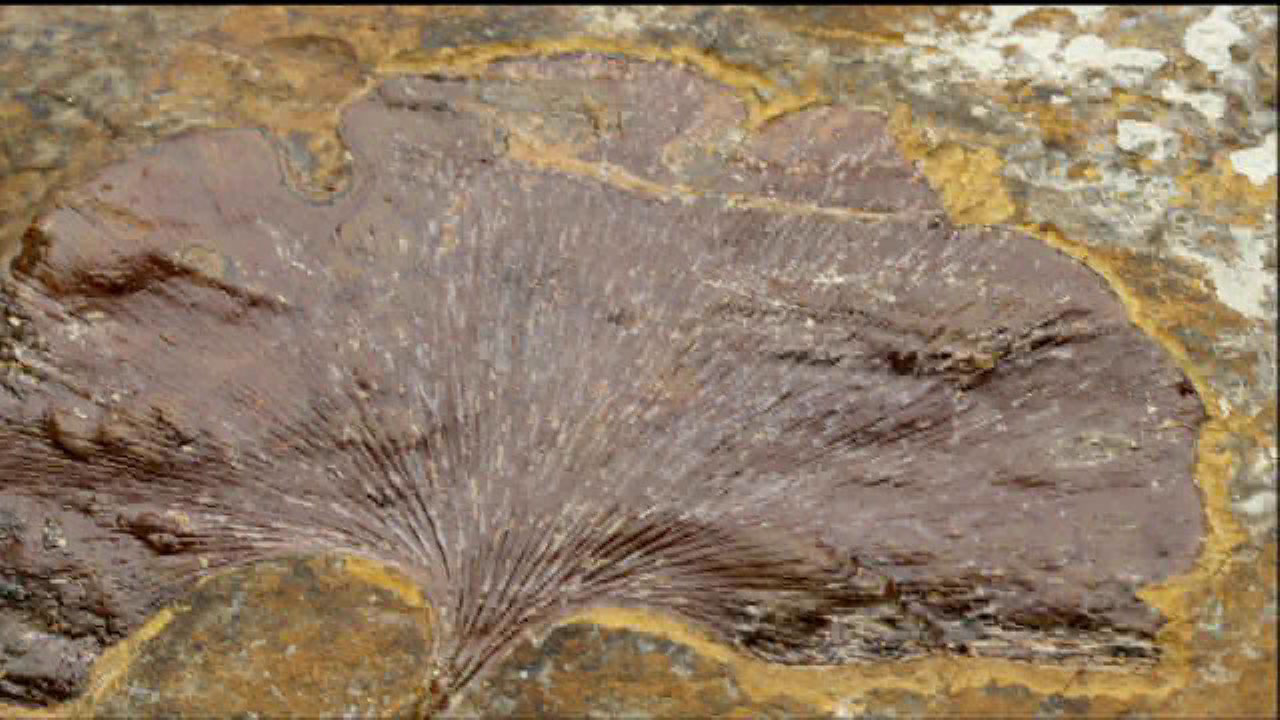
Scientists believe the origin of this super-greenhouse effect came from the great volcanoes dotted along major cracks in the Earth's crust caused by the breakup of the great supercontinent. Scientists gave an estimate on the breakup of the great supercontinent of the south at around 210 million years ago. This was the time when the mid-Atlantic ridge was born between 180 and 210 million years ago. By 160 million years ago, the air was laden with four to five times the carbon dioxide levels than existed just prior to the industrial revolution of the 1800s (or 2.5 times the quantity we see today due primarily to humans burning fossil fuels, but in the Jurassic period we can thank volcanism for this).
The reason why the supercontinent had to break up around 210 million years ago is not precisely known. It is possible that another asteroid may have collided with the Earth (probably over water this time as there is no evidence to show there was a sudden reduction in worldwide temperatures for a brief moment which could have ended the great dinosaur age). Certainly it is known that another major and widespread extinction had occurred nearly 214 million years ago (8) coinciding at about the time of the great supercontinent breaking up. Or maybe it has to do with the way the strong internal heat currents in the magma of the Earth can break the crust into individual, free-moving tectonic plates. We can only speculate at the reason for the break-up of the great supercontinent.
Another suggested reason for global warming at this time could be related to certain types of insects and the high populations they may have reached. For example, the number of termites may have reached plague proportions to the point where the methane they emit together with the greater rate of decomposition of trees by these insects (and from fungi) leading to emission of carbon dioxide could see enough of these greenhouse gases increase global temperatures. One estimate has it that termites can contribute as much as 11 per cent to global warming, and probably higher at the time of the dinosaurs living in the rainforests. To support this view, biologist Joshua King from the University of Central Florida, and Mark A. Bradford, an assistant professor of terrestrial ecosystem ecology at the Yale School of Forestry and Environmental Studies conducted a study on the decomposition rate of plant materials in the presence of fungi and termites and compared this to temperature alone. During the study, samples of wood material were subjected to different but consistent temperatures in two geographical locations and compared the results with the effects of termite and fungi activity. According to the analysis, local factors (i.e., termites and fungi) explained about 75 per cent of the variation in wood decomposition compared to 25 per cent on climate. As Bradford said:
"We've reaching the wrong conclusion about the major controls on decomposition because of the way we've traditionally collected."
Further details of this study can be found in Nature under the title "Climate fails to predict wood decomposition at regional scales", 1 June 2014, available from here.
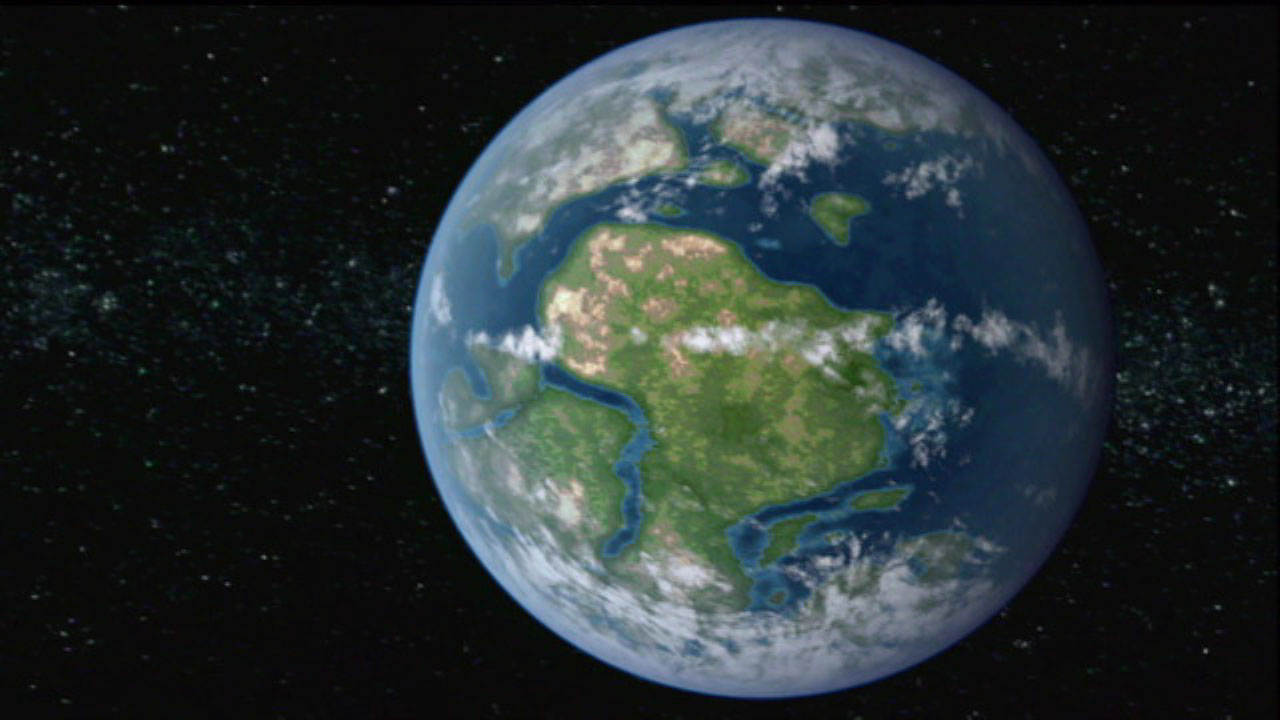
Whatever contributed and had maintained global warming for such a long time (probably starting with the Permian asteroid impact), scientists are certain the weather of 160 million years ago was generally uniform and differences between summer and winter were not apparent. Temperatures at the poles rarely dipped below 10 to 15°C (7); whereas the levels of rainfall were very high, giving rise to more lush and denser tropical plant life across the great supercontinents. In fact, these wet conditions on land were made possible because of extensive plant life covering the supercontinents which in turn retained more moisture on the ground and provided sufficient humidity in the air to fall as rain along certain mountain ranges.
However, things were about to change.
After the end of the Jurassic Period, nearly 136 million years ago, conditions began to get cooler. With fewer volcanoes and enough plant life absorbing carbon dioxide from the atmosphere together with some mountain-building and changes in the position of continents on the Earth's surface, as well as possible changes to the soil chemistry (e.g., less phosphorus to promote the growth of large plants) we see for the first time in more than 50 million years how the Earth began to form polar ice caps. But apparently, this cooling down effect would not last long, as we will see in the Cretaceous period.
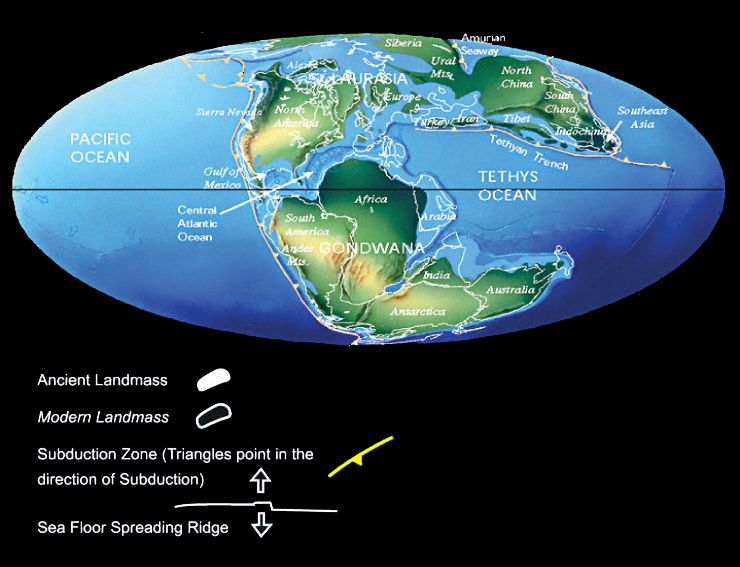
Contradicting the traditional view that mammals at this time were small rodents scampering through the undergrowth searching for food and hiding from the dinosaur predators and weren't adventurous enough to diversify into other forms, a team of researchers from the Chinese Academy of Geological Sciences in Beijing and Carnegie Museum of Natural History in Pittsburgh headed by Dr Qiang Ji of Nanjing University reported in the 24 February 2006 journal Science the fossilized remains of a 60cm long platypus and Beaver-like mammal living 164 million years ago.
The well-preserved fossilized remains was found in 2004 in the inner Mongolian region of China known as Liaoning province.
Aptly named Castorocauda lutrasimilis meaning "beaver tail" (castoro is latin for "beaver" and cauda for "tail") and "like a river otter" (lutra stands for "river otter" and similis meaning "similar") by the discoverers, this interesting cat-sized creature is believed to be the largest known mammal living in the Jurassic period. It possessed limbs claimed to be well-developed for aquatic life including soft-tissue webbing in the hind feet as purportedly seen in the fossil. In fact, preservation of some soft tissue and fur imprints must be seen as a testament to the quality of the find compared to other fossils dated to this period. Scientists suspect the animal swam in rivers and lakes like a platypus, and built nests in burrows along the shore. However its head looked more like a rodent with a broad scaly tail like a beaver, and its sharp teeth looked like an otter designed to eat fish and insects.
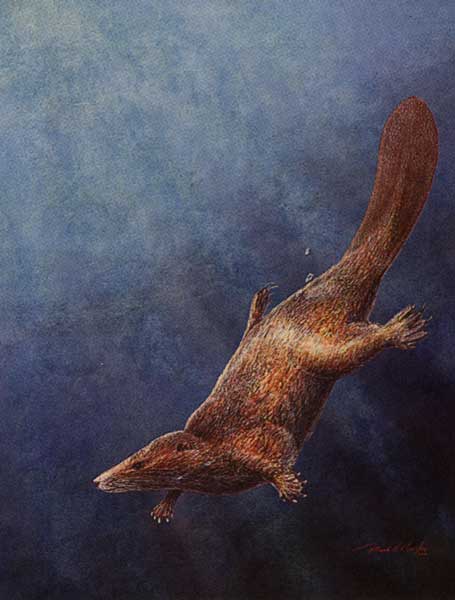
As Dr Zhe-Xi Luo, one of the discoverers of the fascinating creature and curator of vertebrate paleontology at Carnegie Museum of Natural History, said:
"Its lifestyle was probably very similar to the modern day platypus. It probably lived along river or lake banks. It doggy-paddled around, ate aquatic animals and insects, and burrowed tunnels for its nest." (The Canberra Times: Platypus-like mammal fossil surfaces. 25 February 2006, p.18.)
The existence of this animal living in the watery environment has pushed back "the mammalian conquest of the waters by more than 100 million years" according to Dr Thomas Martin, an authority on early mammals at the Senckenberg Research Institute in Frankfurt, Germany.
125 MILLION YEARS AGO
In May 2005, palaeontologists in Utah, USA, claim they have found the missing link in a new species of dinosaur with feathers showing that around 125 million years ago some meat-eating reptiles slowly evolved into plant-eating types. The new feathered dinosaur species supporting this claim is called Falcarius utahensis. It literally means "sickle maker from Utah".
Standing not much taller than 1 metre and roughly 5 metres in length from head to tail, the near complete remains of Falcarius showed it had 10 cm long claws like sickles as commonly found in meat eaters. However the crucial link to herbivores was in the numerous small teeth lining its jaw. Instead of large, sharp pointy teeth to cut meat, the creatures entire teeth structure were more delicate and smaller to handle softer plant materials.
The possibility exists that this species, despite its sinister-looking carnivorous appearance, may have exclusively feasted on plants and nothing else. But no one knows for sure.
As Matthew Carrano, the curator of dinosaurs at the National Museum of Natural History (part of the Smithsonian Institution in Washington), said:
"It's the strangest looking dinosaur you can imagine.
It's as if you sewed the dinosaur together from pieces of other dinosaurs." (The Canberra Times: "Patchwork dino solves evolution puzzle". 7 May 2005, p.21.)
Could the evolutionary progression to plant-eaters (and of the feathers) be an indication that some animals were living in cooler areas frequented by fewer predators away from the oversized daily reptilian bloodbaths taking place in the hotter areas of the planet?
UPDATE
23 November 2006
Like a giant genetic experiment gone wild, another feathered dinosaur had four wings and another creature could do more than glide from one tree to another — it could flap its wings. A wealth of interesting fossils are now starting to emerge from China.
UPDATE
9 June 2014
China is certainly coming up with its fair share of extraordinarily well-preserved and original fossil finds in recent times to make many paleontologists green with envy. The discovery of a flying pterosaur representing a new genus and species known as Hamipterus tianshanensis is certainly no exception. In fact, on closer examination, the eggs themselves (no less than 40 in total) were described by field researcher Wang Youlin as "three-dimensionally [preserved].", together with the parents. Xiaolin Wang of the Chinese Academy of Sciences gave more details of the find when he said:
"Five eggs are three-dimensionally preserved, and some are really complete. It was most exciting to find many male and female pterosaurs and their eggs preserved together."
Scientists have observed how the eggs had a pliable and thin shell on the outside and a soft, thick membrane inside, reminiscent of those found in snakes today. The eggs appeared to have been buried in sandy areas along the edge of an ancient lake mainly for protection from most predators, but also to provide enough moisture to prevent the eggs from drying out. As the eggs were developing and for a short period after the offsprings emerged from the eggs, either the female or male (or perhaps both) parents would come down to regulate the temperature in the sand during the day and to provide some further physical protection to the youngsters from the many small marauding predators roaming the area, especially from the forest nearby, and at night the parents would simply come down and rest on the ground as a large colony. Unfortunately, during a particularly brutal storm that swept over the area about 120 million years ago, it seems a number of these dinosaurs had died. And with no protection from the hot sun the following day, the young animals inside the eggs died as well.

Looking at the well-preserved and complete fossils of the parents and their numbers (so far dozens have been uncovered and more are expected), scientists have been able to provide some remarkable details into the life, gender and general appearance of these somewhat gregarious creatures. What we do know so far is that these dinosaurs loved to stay together in colonies near the shore of a large prehistoric lake. Depending on their age, the wingspan varied between 12 centimetres (for the youngsters) to 25 metres (for the parents) from tip-to-tip, or roughly the length of a tennis court would pretty much give a good indication of the maximum length when the wings are stretched out. There are also clearly distinguishing features between the genders with the male possessing a noticeable and potentially colourful head crest.

As the researchers wrote in their article titled "Sexually Dimorphic Tridimensionally Preserved Pterosaurs and Their Eggs from China" (published in Current Biology on 5 June 2014):
"Sites like the one reported here provide further evidence regarding the behaviour and biology of this amazing group of flying reptiles that has no parallel in modern time."
So expect more information to come about these interesting creatures very soon.
The fossilised skeletons and eggs were first unearthed in 2005 in the Turpan-Hami Basin, south of the Tian Shan Mountains in Xinjiang, northwest of China.
115 MILLION YEARS AGO
The planet Mars may have had conditions more favourable to the Earth at this time than we see today. Of course, whether life actually existed on Mars is still a matter of debate. Nevertheless it is believed that around 115 million years ago, conditions on the small planet started to change drastically.
Mars is the fourth planet in distance from the Sun. It orbits the Sun in a rather unusual elliptical path — as if something may have collided with Mars a long time ago — such that it approaches Earth at its closest every 2 years and 2 months, reaching a point which is half as far away as it is at the farthest position. We also know that this orange-red world rotates about its own inclined axis of 24.935º in 24 hours 37 minutes 23 seconds and has seasons similar to those on Earth except they are much longer due to the extended Martian year of 687.8 Earth days.
More interestingly is the atmosphere. Since Mars is a small planet, it has a low gravitational field. However, this is not the fundamental reason for the Martian atmosphere being feeble today with a pressure of only one-hundredth that on the Earth's surface. An analysis of the concentrations of certain types of isotopes of carbon, oxygen and nitrogen in the atmosphere suggest molecular nitrogen was in much greater quantities in the past than they are presently. This discovery has raised speculation that Mars may have once had a denser atmosphere consisting of mostly carbon dioxide, nitrogen and water, and the climate may have been warmer and wetter. Today, scientists are confident the atmosphere was much more humid, warmer and denser in the past.
The reason for the atmospheric chemical changes and loss in density is still not yet fully understood. But the best explanation so far is that a large asteroid collided with Mars where it penetrated deeply enough and at an angle to reduce the speed of the iron molten core of the planet. Suddenly the magnetic field to protect the planet from the energetic solar wind was suddenly weakened, resulting in the solar wind pushing away enough of the atmospheric gases to reduce the density. Finally the change in the chemical structure of the atmosphere was caused by the emissions of carbon dioxide and other gases from its interior through volcanic activity. If this is so, then Olympus Mons, a tremendously oversized Martian volcano and its other close neighbouring volcanoes on the Martian equator, may well be the remnants of such a catastrophic event.
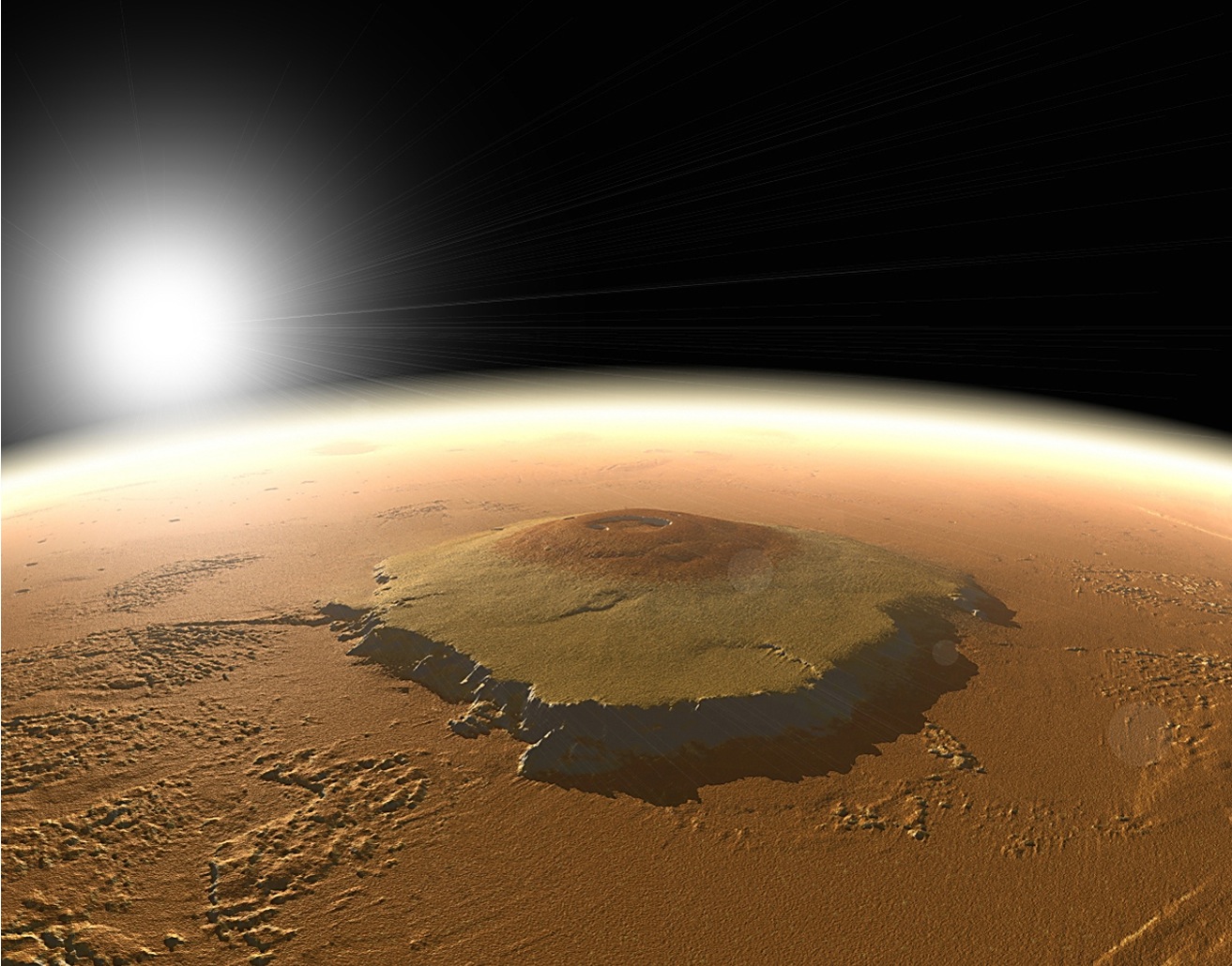
So far, scientists are placing the origins of Olympus Mons at around 115 million years ago. But the precise date is difficult to determine as the great volcanic mountain has, as recently as 2 million years ago, being spewing lava thus making it difficult for scientists to calculate the number of craters that have hit this region of the planet at the present time.
Otherwise if this was not a collision of any sort, then one must be inclined to follow the recommended timeline as published in the journal of Science dated 21 April 2006 for how Mars has changed. According to the article published in the journal, an international team of scientists headed by Jean-Pierre Bibring of France's Institute for Space Astrophysics claim if Mars was hospitable at some point in its history, it would have occurred not long after the planet's formation nearly 4.6 billion years ago. Another 600 million years later, a second era began whereby volcanic activity become the dominating feature of the planet. This is the period where it is believed that the volcanic sulfur began to dry up the environment. The third and final era is marked by the formation of ferric oxides (the reddish material we see on the surface of Mars) not created or altered by water.
Although no life has been detected so far, according to the data received from experiments performed by the United States Viking landers, project scientist Gerald A. Soffen has still kept the question of extraterrestrial life on Mars open for speculation. He states:
"We have not visited the polar regions. I have always believed that in the search for life you must go where the water is. The permanent polar caps of Mars are frozen water and would act as a splendid "cold finger" to trap organic molecules. Who knows what those lucky future explorers of Mars will find there?"